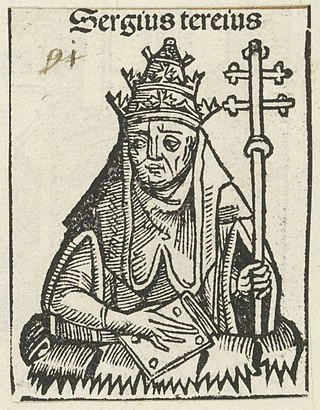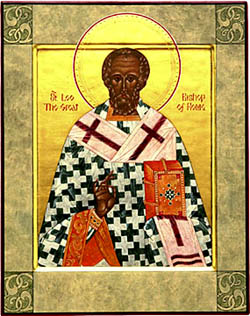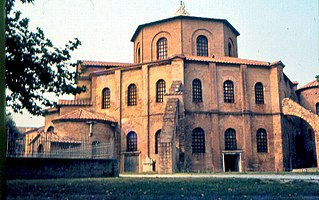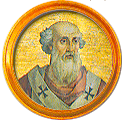An antipope is a person who claims to be Bishop of Rome and leader of the Catholic Church in opposition to the legitimately elected pope. Between the 3rd and mid-15th centuries, antipopes were supported by factions within the Church itself and secular rulers.

Pope Gregory XII, born Angelo Corraro, Corario, or Correr, was head of the Catholic Church from 30 November 1406 to 4 July 1415. Reigning during the Western Schism, he was opposed by the Avignon claimant Benedict XIII and the Pisan claimants Alexander V and John XXIII. Gregory XII wanted to unify the Church and voluntarily resigned in 1415 to end the schism.

Pope Sergius I was the bishop of Rome from 15 December 687 to his death, and is revered as a saint by the Roman Catholic Church. He was elected at a time when two rivals, Paschal and Theodore, were locked in a dispute about which of them should become pope. His papacy was dominated by his response to the Quinisext Council, the canons of which he steadfastly refused to accept. Thereupon Emperor Justinian II ordered Sergius' arrest, but the Roman people and the Italian militia of the exarch of Ravenna refused to allow the exarch to bring Sergius to Constantinople.

Pope Sergius III was the bishop of Rome and nominal ruler of the Papal States from 29 January 904 to his death. He was pope during a period of violence and disorder in central Italy, when warring aristocratic factions sought to use the material and military resources of the papacy. At the behest of Theophylact I of Tusculum, Sergius seized the papal throne from Antipope Christopher, who in turn had deposed Pope Leo V. Sergius' reign was subsequently marked by Theophylact's influence. As pope, Sergius continued many ecclesiastical controversies of his predecessors, including conflict over Pope Formosus' legacy, annulling all ordinations made by the late pope, and the filioque controversy with eastern patriarchs. His pontificate was similarly marked by temporal conflicts, with Sergius' refusal to crown Berengar I of Italy as Holy Roman Emperor, and his support of Byzantine Emperor Leo VI the Wise's fourth marriage. Sergius also saw the restoration of the Lateran Palace.
Pope Leo V was the bishop of Rome and nominal ruler of the Papal States from July 903 to his death in February 904. He was pope immediately before the period known as the Saeculum obscurum, when popes wielded little temporal authority.
Pope John XI was the bishop of Rome and nominal ruler of the Papal States from March 931 to his death. The true ruler of Rome at the time was his mother, Marozia, followed by his brother Alberic II. His pontificate occurred during the period known as Saeculum obscurum.

The Cadaver Synod is the name commonly given to the ecclesiastical trial of Pope Formosus, who had been dead for about seven months, in the Basilica of St. John Lateran in Rome during January 897. The trial was conducted by Pope Stephen VI, the successor to Formosus' successor, Pope Boniface VI. Stephen had Formosus' corpse exhumed and brought to the papal court for judgment. He accused Formosus of perjury, of having acceded to the papacy illegally, and illegally presiding over more than one diocese at the same time. At the end of the trial, Formosus was pronounced guilty, and his papacy retroactively declared null.

Saeculum obscurum, also known as the Pornocracy or the Rule of the Harlots, was a period in the history of the papacy during the first two thirds of the 10th century, following the chaos after the death of Pope Formosus in 896 which saw seven or eight papal elections in as many years. It began with the installation of Pope Sergius III in 904 and lasted for 60 years until the death of Pope John XII in 964. During this period, the popes were influenced strongly by a powerful and allegedly corrupt aristocratic family, the Theophylacti, and their relatives and allies. The era is seen as one of the lowest points of the history of the papal office.
Antipope John VIII or Antipope John was an antipope of the Roman Catholic church, in the year 844. On the death of Pope Gregory IV, the populace of Rome declared John, a deacon with no known links to the aristocracy as his successor. They seized the Lateran Palace and enthroned him there. However, the lay aristocracy elected as pope the elderly, nobly born archpriest Sergius, ejected John from the Lateran, and swiftly crushed the opposition. Pope Sergius II's consecration was rushed through immediately, without waiting for imperial ratification from the Frankish court. Although some of his supporters wanted John put to death for what they considered his presumption, Sergius intervened to save his life and John was confined to a monastery. Nothing further is known about him.

Patriarch of the West was, on several occasions between AD 450 and 2006, one of the official titles of the Bishop of Rome, as patriarch and highest authority of the Latin Church. The title no longer appears among the official ones, starting from the publication of the 2006 Annuario Pontificio.
Auxilius of Naples was an ecclesiastical writer. To him are attributed a series of writings that deal with the controversies concerning the succession and fate of Pope Formosus (891–896), and especially the validity of the orders conferred by him. Auxilius was a Frank, who was ordained a priest, or perhaps only a deacon, in Rome by Formosus, and lived later in southern Italy, apparently at Naples.
Eugenius Vulgarius was an Italian priest and poet.
The numbering of "Popes John" does not occur in strict numerical order. Although there have been twenty-one legitimate popes named John, the numbering has reached XXIII because of two clerical errors that were introduced in the Middle Ages: first, antipope John XVI was kept in the numbering sequence instead of being removed; then, the number XX was skipped because Pope John XXI counted John XIV twice.

The Byzantine Papacy was a period of Byzantine domination of the Roman Papacy from 537 to 752, when popes required the approval of the Byzantine Emperor for episcopal consecration, and many popes were chosen from the apocrisiarii or the inhabitants of Byzantine-ruled Greece, Syria, or Sicily. Justinian I reconquered the Italian peninsula in the Gothic War (535–554) and appointed the next three popes, a practice that would be continued by his successors and later be delegated to the Exarchate of Ravenna.

The Lateran Council of 769 was a synod held in the Basilica of St. John Lateran to rectify perceived abuses in the papal electoral process which had led to the elevation of the antipopes Constantine II and Philip. It also condemned the rulings of the Council of Hieria. It is perhaps the most important Roman council held during the 8th century.

The titles of the bishop of Rome, more often referred to as the papal titles, refer to the various titles used by protocol, as a form of addressing or designating a theological or secular reality of the bishop of Rome (pope). The Catholic Church believes that they "constitute what has been termed a primacy of honor. These prerogatives are not, like his jurisdictional rights, tied to the divine jure of his office. They have grown in the course of history, and have been enshrined by the passage of centuries, but they are not free from modification."









